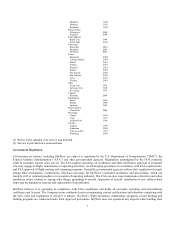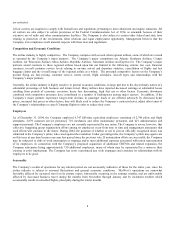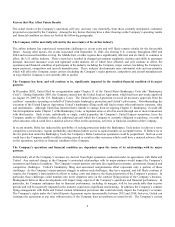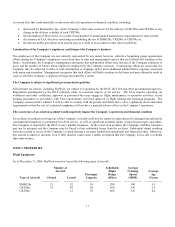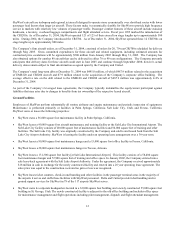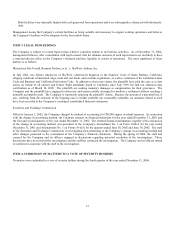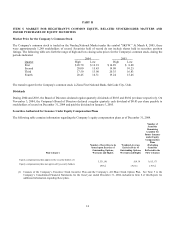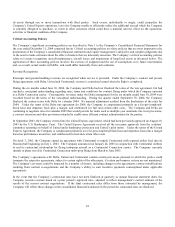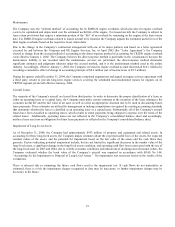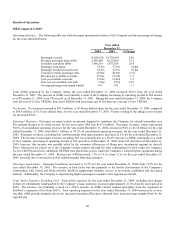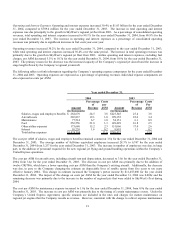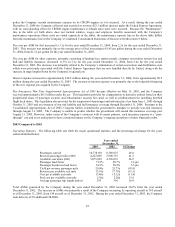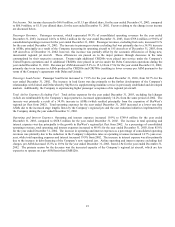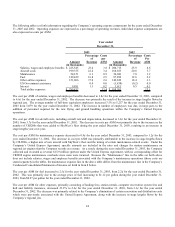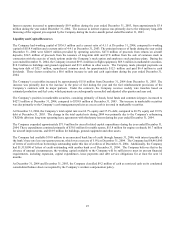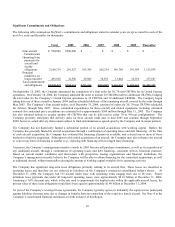SkyWest Airlines 2004 Annual Report Download - page 19
Download and view the complete annual report
Please find page 19 of the 2004 SkyWest Airlines annual report below. You can navigate through the pages in the report by either clicking on the pages listed below, or by using the keyword search tool below to find specific information within the annual report.17
ITEM 7. MANAGEMENT’S DISCUSSION AND ANALYSIS OF FINANCIAL CONDITION AND RESULTS OF
OPERATIONS
Overview
The Company, through its wholly-owned subsidiary, SkyWest, operates one of the larger independent regional airlines in the
United States. SkyWest offers scheduled passenger and air freight service with approximately 1,500 daily departures to 117 cities
in 31 states and three Canadian provinces. Additionally, SkyWest provides customer handling services for approximately ten
other airlines throughout SkyWest’s system. SkyWest has been a partner with Delta in Salt Lake City and United in Los Angeles
since 1987 and 1997, respectively. In 1998, SkyWest expanded its relationship with United to provide service in Portland,
Seattle/Tacoma, San Francisco and additional Los Angeles markets. In 2001, SkyWest expanded its operations to serve as the
Delta Connection in Dallas/Fort Worth. However, effective January 31, 2005, SkyWest re-deployed all its Delta Connection
flights to Salt Lake City as a result of Delta’s decision to “de-hub” its Dallas/Fort Worth operations. In April 2003, SkyWest
signed an agreement with Continental to supply Continental with regional airline feed into Continental’s Houston hub effective on
July 1, 2003. In January 2005, SkyWest and Continental announced their mutual decision to end SkyWest’s operations as a
Continental Connection carrier not later than June, 2005. In 2004, SkyWest expanded its United Express operations to provide
service in Chicago. Today, SkyWest operates as a Delta Connection carrier in Salt Lake City and as a United Express carrier in
Los Angeles, San Francisco, Denver, Chicago and the Pacific Northwest. SkyWest believes its success in attracting multiple
contractual relationships with major airline partners is attributable to its delivery of high-quality customer service with an all
cabin-class fleet at a competitive cost structure. As of December 31, 2004, approximately 40% of SkyWest’s capacity (measured
in ASMs) was operated under the Delta code, approximately 59% was operated under the United code and approximately 1% was
operated under the Continental code. As of December 31, 2004, SkyWest operated a fleet of 73 EMB120s, (50 United, 14 Delta
and nine Continental), 121 CRJ200s (65 United, 56 Delta with four SkyWest spares), and 12 CRJ 700s with United.
Historically, multiple contractual relationships have enabled SkyWest to reduce reliance on any single major airline code and to
enhance and stabilize operating results through a mix of SkyWest-controlled or “prorate” flying and contract flying. On contract
routes, the major airline partner controls scheduling, ticketing, pricing and seat inventories and SkyWest is compensated by the
major airline partner at contracted rates based on the completed block hours, flight departures and other operating measures. On
prorate flights, SkyWest controls scheduling, ticketing, pricing and seat inventories and receives a prorated portion of passenger
fares. As of March 1, 2005, essentially all of the Company’s EMB120s flown for Delta and Continental were flown under prorate
arrangements. As of March 1, 2005, approximately 92% of the Company’s EMB120s flown in the United system were flown
under contractual arrangements, with the remaining eight percent flown under prorate arrangements.
On September 15, 2003, the Company announced the completion of a firm order for 30, 70-seat CRJ700s for its United Express
operations. On February 10, 2004, the Company amended the order to include ten additional CRJ200s and two additional
CRJ700s, bringing the total order for the Company’s United Express operations to 32 CRJ700s and ten CRJ200s. The Company
began taking delivery of these aircraft in January 2004 and has scheduled delivery of the remaining aircraft covered by the order
through May 2005. The Company’s firm aircraft orders, as of December 31, 2004, consisted of orders for 20, CRJ700s scheduled
for delivery through May 2005. Gross committed expenditures for these aircraft and related equipment, including estimated
amounts for contractual price escalations are estimated to be approximately $500 million through May 31, 2005. Additionally,
the Company’s agreement with Bombardier, Inc. includes options for another 80 aircraft that can be delivered in either 70 or 90-
seat configurations. The Company presently anticipates that delivery dates for these aircraft could start in June 2005 and continue
through September 2008; however, actual delivery dates remain subject to final determination as agreed upon by the Company
and United.
In December 2002, United filed for reorganization under Chapter 11 of the United States Bankruptcy Code. During September
2003, the Company entered into the United Express Agreement, which sets forth the principal terms and conditions governing the
Company’s United Express operations. The United Express Agreement received all necessary approvals from the U.S.
Bankruptcy Court, creditors’ committee operating on behalf of United under bankruptcy protection and United’s pilot union.
Under the terms of the United Express Agreement, the Company is compensated primarily on a fee-per-completed-block hour and
departure basis, plus a margin based on performance incentives, and reimbursed for fuel and other costs. Notwithstanding the
execution of the United Express Agreement, United’s bankruptcy filing could still lead to many other unforeseen expenses, risks
and uncertainties. Although United has reported that it intends to emerge from its ongoing Chapter 11 bankruptcy on or before
June 30, 2005, it could still file for liquidation under Chapter 7 of the United States Bankruptcy Code, or liquidate some or all of


